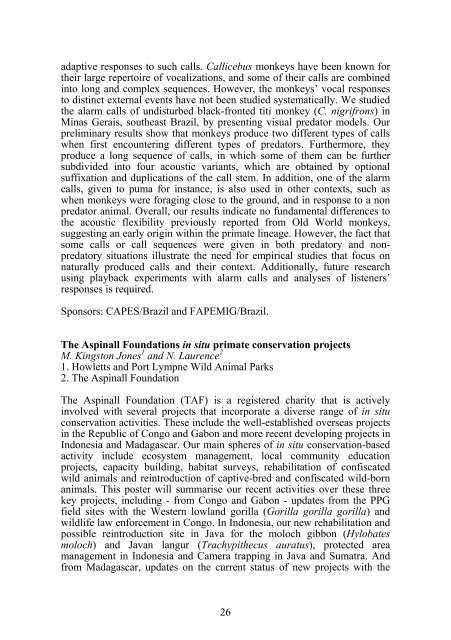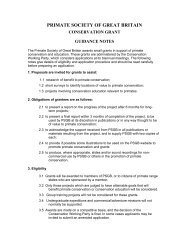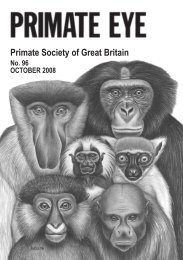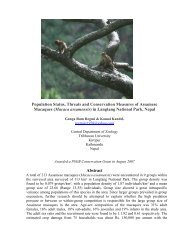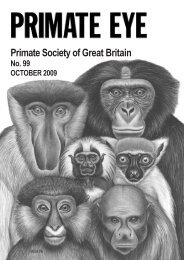2010 Vol 101.pdf (1.63mb) - Primate Society of Great Britain
2010 Vol 101.pdf (1.63mb) - Primate Society of Great Britain
2010 Vol 101.pdf (1.63mb) - Primate Society of Great Britain
Create successful ePaper yourself
Turn your PDF publications into a flip-book with our unique Google optimized e-Paper software.
adaptive responses to such calls. Callicebus monkeys have been known for<br />
their large repertoire <strong>of</strong> vocalizations, and some <strong>of</strong> their calls are combined<br />
into long and complex sequences. However, the monkeys’ vocal responses<br />
to distinct external events have not been studied systematically. We studied<br />
the alarm calls <strong>of</strong> undisturbed black-fronted titi monkey (C. nigrifrons) in<br />
Minas Gerais, southeast Brazil, by presenting visual predator models. Our<br />
preliminary results show that monkeys produce two different types <strong>of</strong> calls<br />
when first encountering different types <strong>of</strong> predators. Furthermore, they<br />
produce a long sequence <strong>of</strong> calls, in which some <strong>of</strong> them can be further<br />
subdivided into four acoustic variants, which are obtained by optional<br />
suffixation and duplications <strong>of</strong> the call stem. In addition, one <strong>of</strong> the alarm<br />
calls, given to puma for instance, is also used in other contexts, such as<br />
when monkeys were foraging close to the ground, and in response to a non<br />
predator animal. Overall, our results indicate no fundamental differences to<br />
the acoustic flexibility previously reported from Old World monkeys,<br />
suggesting an early origin within the primate lineage. However, the fact that<br />
some calls or call sequences were given in both predatory and nonpredatory<br />
situations illustrate the need for empirical studies that focus on<br />
naturally produced calls and their context. Additionally, future research<br />
using playback experiments with alarm calls and analyses <strong>of</strong> listeners’<br />
responses is required.<br />
Sponsors: CAPES/Brazil and FAPEMIG/Brazil.<br />
The Aspinall Foundations in situ primate conservation projects<br />
M. Kingston Jones 1 and N. Laurence 2<br />
1. Howletts and Port Lympne Wild Animal Parks<br />
2. The Aspinall Foundation<br />
The Aspinall Foundation (TAF) is a registered charity that is actively<br />
involved with several projects that incorporate a diverse range <strong>of</strong> in situ<br />
conservation activities. These include the well-established overseas projects<br />
in the Republic <strong>of</strong> Congo and Gabon and more recent developing projects in<br />
Indonesia and Madagascar. Our main spheres <strong>of</strong> in situ conservation-based<br />
activity include ecosystem management, local community education<br />
projects, capacity building, habitat surveys, rehabilitation <strong>of</strong> confiscated<br />
wild animals and reintroduction <strong>of</strong> captive-bred and confiscated wild-born<br />
animals. This poster will summarise our recent activities over these three<br />
key projects, including - from Congo and Gabon - updates from the PPG<br />
field sites with the Western lowland gorilla (Gorilla gorilla gorilla) and<br />
wildlife law enforcement in Congo. In Indonesia, our new rehabilitation and<br />
possible reintroduction site in Java for the moloch gibbon (Hylobates<br />
moloch) and Javan langur (Trachypithecus auratus), protected area<br />
management in Indonesia and Camera trapping in Java and Sumatra. And<br />
from Madagascar, updates on the current status <strong>of</strong> new projects with the<br />
26


